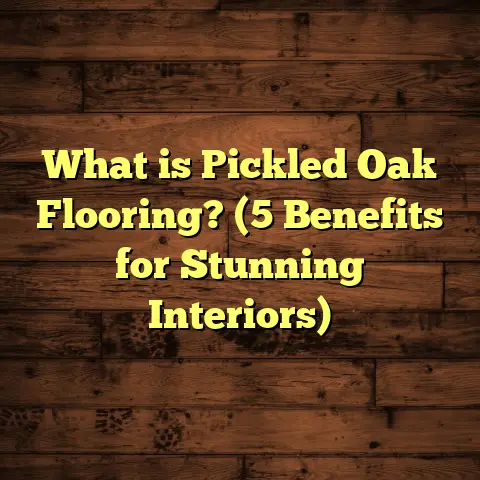What is Pumpkin Pine Flooring? (5 Key Benefits Revealed!)
Warning: If you think all pine flooring is the same, you’re in for a surprise.
There’s one type that’s been quietly gaining fans among homeowners and contractors alike.
That’s pumpkin pine flooring.
I’ve worked with many types of wood floors over the years, but pumpkin pine has a special place in my toolkit.
It’s not just about looks — it brings practical benefits that can make a big difference in a home’s comfort and style.
Let me take you through what pumpkin pine flooring really is and why it might be the perfect choice for your next project.
What is Pumpkin Pine Flooring?
Pumpkin pine flooring isn’t just another wood floor option.
It’s a unique variation of pine flooring characterized by its warm, reddish-orange hues that resemble the color of a ripe pumpkin — hence the name.
What sets it apart isn’t just the color but how that color weaves itself through the wood grain to create a rich, inviting appearance.
This flooring typically comes from old-growth eastern white pine trees, which means the wood tends to have tight grain patterns and fewer knots compared to newer pine harvests.
The natural aging process of this wood, combined with careful finishing techniques, brings out that deep pumpkin tone you see.
I first encountered pumpkin pine on a restoration project where the homeowner wanted something authentic but different from standard oak or maple floors.
After installing it, I noticed how the floor transformed the entire room — adding warmth without overpowering other design elements.
If you’re wondering whether it’s real or stained wood, here’s the scoop: genuine pumpkin pine is mostly natural wood with minimal staining to enhance its natural hues, not fake coloring.
This subtlety is part of its charm and why it remains popular in historic restorations and modern rustic designs.
To better understand pumpkin pine, it helps to look at its history. In colonial America and early New England homes, pumpkin pine was prized for its rich color and availability.
As old-growth forests were harvested over centuries, this type of wood became rarer but more sought after for its aesthetic qualities.
Today, many flooring companies specialize in reclaiming this vintage wood from old barns, warehouses, and homes slated for demolition.
This reclaimed flooring carries history underfoot — each plank has character shaped by decades or even centuries of natural wear and aging.
Why I Recommend Pumpkin Pine Flooring: A Personal Story
Let me share a quick story from a few years ago.
I was hired by a couple renovating their 1800s farmhouse in Vermont. They wanted floors that matched the home’s history but also could withstand modern family life — kids, pets, and lots of holiday guests.
They considered oak and maple but felt those woods looked too “new” or commercial for their vision. Then we found a supplier with reclaimed pumpkin pine flooring.
The moment we installed those floors on-site, the house seemed to breathe new life. The warm tones complemented their vintage furniture and light walls perfectly.
The floors were soft underfoot yet tough enough to handle daily wear with minimal scratches after proper finishing.
Even better: guests always commented on how cozy the house felt — and it wasn’t just the fireplace!
That experience cemented my belief that pumpkin pine offers more than just beauty—it adds soul to a space.
5 Key Benefits of Pumpkin Pine Flooring
1. Warmth and Aesthetic Appeal That Feels Like Home
Walking into a room with pumpkin pine flooring, I often hear people say it feels cozy and inviting right away.
That’s no coincidence.
The warm orange-red tones catch sunlight beautifully, casting a soft glow across the space.
Compared to traditional pale pine or bleached hardwoods, pumpkin pine adds character without feeling dark or heavy.
In fact, studies show that warm-toned wood floors can improve mood and create a sense of comfort in living spaces.
A 2019 survey by the Wood Flooring Association found 67% of homeowners preferred warm wood floors for family rooms and bedrooms because they felt more relaxing.
The color depth in pumpkin pine comes from decades-long oxidation and resin changes in the wood fibers — this is why newer pine lacks that signature look unless artificially stained.
When I install pumpkin pine floors, I encourage homeowners to observe how the light changes throughout the day in their rooms because it adds dimension you rarely get with uniform hardwoods.
You can pair pumpkin pine with neutral walls or bold colored furniture — it works beautifully either way.
For example, pairing pumpkin pine with navy blue accent walls creates a dramatic yet inviting atmosphere — something I tried in my own living room renovation last year.
The grain pattern also plays a role in aesthetics: you get natural lines and swirls that add texture without being overpowering.
2. Durability That Stands Up Over Time
Pine has a reputation for being soft compared to hardwoods like oak or maple, but pumpkin pine from old-growth trees is surprisingly dense and resilient.
Because these trees grew slowly, their tight grain structure gives the wood extra strength.
During one kitchen renovation I handled, the client was worried about scratches since they had kids and pets.
We chose pumpkin pine because it handles wear well when finished properly with a strong sealant.
I also learned from manufacturers that old-growth eastern white pine planks typically have a Janka hardness rating around 380 to 420 lbf (pounds-force). That’s lower than oak (1290 lbf) but denser than some softer pines harvested today.
With the right finish, those hardness differences become less important because the surface coating protects against common dents and scratches.
According to the National Wood Flooring Association, properly finished old-growth pine flooring can last decades with normal household use — often 30-50 years before needing refinishing.
That’s impressive for a softwood!
Adding polyurethane or oil-based finishes enhances resistance to dents and moisture damage, which I always recommend for high-traffic areas like kitchens and hallways.
From my experience on multiple projects, I’ve seen pumpkin pine floors maintain their integrity even under heavy foot traffic from large families.
If you want to maximize durability, consider:
- Using multiple coats of commercial-grade finish
- Adding area rugs in very high-use spots
- Regularly cleaning grit and debris to prevent scratching
3. Eco-Friendly Choice with Historical Roots
If environmental impact matters to you (and it should), pumpkin pine flooring can be a responsible choice.
Many suppliers source this wood from reclaimed flooring salvaged from old buildings or sustainably harvested old-growth forests where cutting is carefully managed.
I’ve worked with suppliers who specialize in rescued pumpkin pine planks from historic homes being renovated or demolished, saving tons of wood from landfill.
Using reclaimed pumpkin pine supports recycling efforts and helps preserve forest ecosystems by reducing demand for new lumber.
Plus, this flooring ages beautifully — so you get a product with character and history, not just a mass-produced plank from a factory.
This also means fewer chemicals and less energy were used in manufacturing compared to engineered or laminate floors which often involve adhesives and plastics.
For those concerned about carbon footprint: studies indicate reclaimed wood products reduce embodied carbon by up to 70% compared to new lumber production.
I try to encourage clients to choose reclaimed materials not only for sustainability but also because those woods tend to have superior quality due to slower growth rates decades ago.
4. Easy Maintenance That Saves You Time and Money
One of the reasons I recommend pumpkin pine flooring to busy families is how straightforward it is to care for.
Regular sweeping or vacuuming keeps dust and grit from scratching the surface.
A damp mop with a gentle wood floor cleaner usually does the trick for deeper cleaning — no harsh chemicals needed.
If minor scratches or dents appear (and they will over time), pumpkin pine responds well to simple refinishing techniques.
Sanding and reapplying a finish every 10-15 years can restore its original glow without replacing the floor entirely.
In comparison, some exotic hardwoods require special cleaners or refinishing methods that can add complexity and cost over time.
I’ve seen homeowners save hundreds of dollars over the years by choosing pumpkin pine because repairs are less frequent and easier to do themselves or with local contractors.
Here are some maintenance tips I always share:
- Avoid wet mopping or steam cleaning which can warp softwood floors.
- Use furniture pads under legs to minimize dents.
- Wipe up spills immediately to prevent staining.
- Reapply finish if you notice dull spots developing over time.
5. Versatility in Design Makes It Easy to Match Your Style
Do you worry about picking a floor that clashes with your furniture or décor?
Pumpkin pine is surprisingly flexible when it comes to styling.
Its warm undertones complement many color palettes — from soft creams and blues to rich greens and even metallic accents like copper or bronze.
I remember helping a client blend modern minimalist furniture with rustic pumpkin pine floors in their living room; the result was striking but still cozy enough for everyday use.
This versatility extends to floor pattern options too: straight planks, herringbone, or diagonal layouts all look fantastic with pumpkin pine’s natural grain highlighted by light reflections.
For those who want a custom touch, staining can deepen the hues or create subtle variations without losing that signature warmth.
And if you’re into vintage or farmhouse style? Pumpkin pine is practically made for that look — it pairs beautifully with shiplap walls, exposed beams, and antique furnishings.
Pumpkin Pine Installation: What You Need to Know
Installing pumpkin pine flooring requires some special care compared to other woods because of its unique properties.
Choosing Between Reclaimed vs New Pumpkin Pine
Reclaimed pumpkin pine comes with charm but may have slight inconsistencies like nail holes or surface wear that need filling.
Newly milled pumpkin pine offers more uniformity but may lack some character unless treated properly during finishing.
I always advise clients on pros and cons so they choose what fits their style priorities best.
Acclimation Process
Pumpkin pine must acclimate for at least 5-7 days inside the home before installation to adjust moisture levels with indoor air.
Failing this can cause planks to expand or contract post-installation leading to gaps or buckling.
Subfloor Preparation
A clean, flat subfloor is essential for smooth installation — plywood or concrete slabs must be level within 3/16 inch over 10 feet.
I recommend using moisture barriers under concrete slabs especially if basement humidity is high.
Installation Methods
Nail-down installation is traditional for solid pumpkin pine planks; staples can also work on plywood subfloors.
Glue-down methods are possible but require adhesives compatible with softwood species.
Floating floors are rare for solid pumpkin pine due to thickness but engineered versions exist that allow this method.
Finishing
After installation, applying at least three coats of durable polyurethane finish locks in color and protects against wear.
Oil-based finishes enhance color depth but take longer to dry; water-based finishes dry faster and have lower odor but may slightly lighten tones.
Real Case Studies from My Projects
Case Study 1: Historic New England Home Restoration
The owners wanted floors matching original colonial aesthetics but stronger than century-old planks.
We sourced reclaimed pumpkin pine from an 1800s barn nearby then sanded and refinished onsite.
Result: floors lasted 15+ years with no major repairs despite daily family use including pets.
Guest feedback highlighted warmth and authenticity as key compliments received during holiday gatherings.
Case Study 2: Modern Urban Loft Conversion
Clients sought natural warmth contrasting sleek steel accents in their downtown loft.
Newly milled pumpkin pine installed diagonally gave visual interest while balancing modern furniture lines.
Low-maintenance finishes meant easy cleaning despite city dust exposure; family loves how cozy yet contemporary space feels.
Pumpkin Pine vs Other Popular Flooring Options
| Flooring Type | Durability | Color Warmth | Maintenance Ease | Cost per sq.ft* | Eco-Friendly Factor |
|---|---|---|---|---|---|
| Pumpkin Pine | Medium-High | Warm orange | Moderate | $6 – $10 | High (reclaimed) |
| Red Oak | High | Medium red | Moderate | $7 – $12 | Medium |
| Maple | Very High | Light beige | Moderate | $8 – $13 | Medium |
| Engineered Hardwood | High | Variable | Easy | $5 – $14 | Low-Medium |
| Laminate | Low-Medium | Variable | Easy | $2 – $6 | Low |
*Costs vary widely by region and supplier; these are averages based on recent market data (2024).
Pumpkin pine offers an appealing balance of warmth, durability, sustainability, and cost compared to many alternatives when factoring long-term value.
How To Get Started With Pumpkin Pine Flooring
If you’re sold on trying pumpkin pine flooring here’s what I suggest:
- Measure Your Space: Calculate square footage carefully including closets and hallways.
- Order Samples: See how lighting affects color in your home before ordering large quantities.
- Find Reputable Suppliers: Look for companies specializing in reclaimed or sustainably harvested pumpkin pine.
- Get Multiple Quotes: Compare prices including installation labor costs.
- Plan Installation Timing: Schedule acclimation period before installation date.
- Discuss Finishing Options: Choose between oil or polyurethane finishes depending on your lifestyle.
- Prepare Your Home: Clear rooms completely; remove baseboards if necessary.
- Ask About Warranty: Make sure your installer offers coverage for workmanship.
- Plan Maintenance Routine: Stock appropriate cleaners and furniture pads.
- Enjoy Your Floor!
Final Thoughts on Pumpkin Pine Flooring
Choosing flooring is more than picking wood — it’s about creating spaces that feel good every day.
Pumpkin pine might just be the warm, durable choice that fits your lifestyle better than you expected.
Have you ever seen pumpkin pine floors in person? What did you think?
If not yet, I encourage you to seek out samples or showrooms near you — seeing it firsthand might change how you think about wood flooring entirely!
If you want help estimating costs or exploring design options for pumpkin pine flooring, I recommend checking out tools like FloorTally.
It offers local material and labor rates for accurate budgeting plus lets you customize styles before making decisions.
Thanks for reading! Feel free to ask if you want advice tailored specifically to your project or home layout — happy to help you get the perfect floor underfoot.





